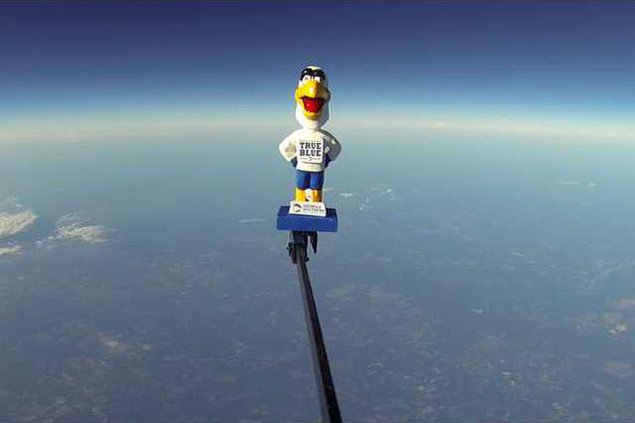Georgia Southern University has embarked on a bold journey where no Eagle has ever gone before. GUS, the university’s mascot, has landed safely after being launched into the stratosphere on a mission to promote STEM (Science, Technology, Engineering and Math) learning.
To gain a bird’s-eye view of earth, a GUS figurine was attached to a weather balloon and a rig with multiple high definition video cameras and tracking equipment for lift-off at Paulson Stadium. GUS reached an altitude of 102,000 feet before the weather balloon burst and a parachute returned the Eagle mascot to earth. He traveled more than 70 miles and touched down in some woods outside Mount Vernon.
"GUS in Space wasn’t just a gimmick because there was a lot of technology behind it," said university President Brooks A. Keel. "This was a great experiment for our university to blend the wow factor with real science, technology, engineering and math and give our students an opportunity to put textbook material into a real-life situation for a great learning experience."
The GUS in Space project included the Center for Academic Technology Support, faculty, staff and two students, Cameron Cato and Jeremy Goodman who were responsible for designing the telemetry system to track GUS.
"It was quite impressive that what we made could go up more than 100,000 feet and survive the extreme cold of 95 degrees below zero," explained Cato. "All the electronics came through in great shape and were working fine when we recovered GUS."
Goodman took pride in his role in sending GUS into the stratosphere.
"The cameras captured some amazing video which shows the curvature of the earth and should help promote STEM education," said Goodman. "This is an exciting experience. How many people can say they put something into near space?"
The goal of GUS in Space was to showcase the university’s efforts in STEM education which include practical, hands-on use of technology in the telemetry, satellite and antenna labs.
"It’s not difficult to launch something into space with a weather balloon, but to track its every move from launch to landing was really something special for our students," said Vice President for Research and Economic Development Charles Patterson. "By being able to show the science behind such a fun and entertaining project, we hope to get more children interested in STEM careers."
Associate Dean of Faculty and Research Programs Karin Scarpinato said this experiment demonstrated that science does not have to be boring or intimidating and that GUS in Space brought people together who typically don’t work with each other.
"This definitely shows how important it is to be interdisciplinary in STEM education, but also shows that what you learn in the classroom can be applied in real life whether it’s doing something fun like putting GUS in space or in a career choice where you will need the same skills," said Scarpinato.
Watch the GUS in Space video by visiting GeorgiaSouthern.edu/newsroom. The direct link to the video on YouTube is http://youtu.be/MqtIip7qIdo.





